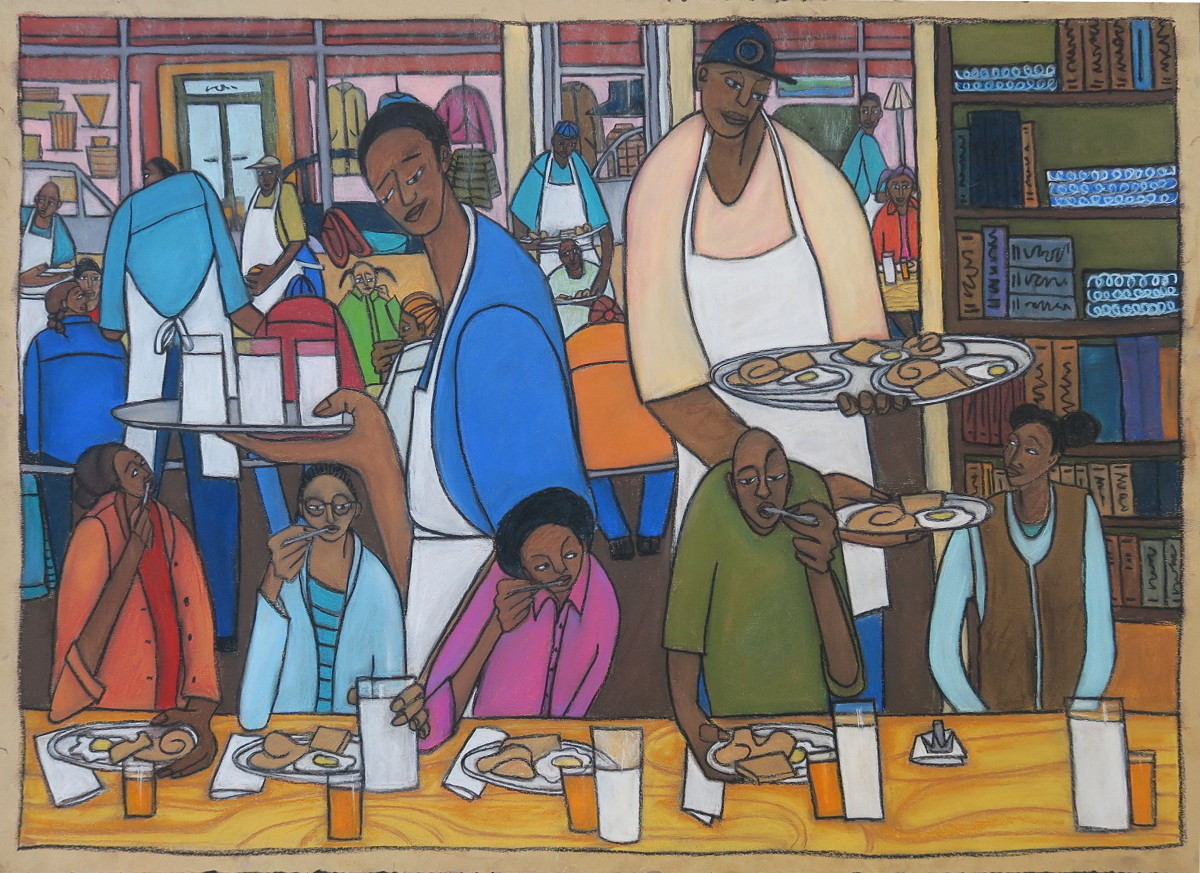
19.5″ x 29″ pastel on paper $1,150 framed
The Free Breakfast for School Children Program, or the People’s Free Food Program, was a community service program run by the Black Panther Party that focused on providing free breakfast for children before school. The program began in January 1969 at Father Earl A. Neil’s St. Augustine’s Episcopal Church, located in West Oakland, California and spread throughout the nation. This program was an early manifestation of the social mission envisioned by Black Panther Party founders Huey P. Newton and Bobby Seale, along with their founding of the Oakland Community School, which provided high-level education to 150 children from impoverished urban neighborhoods. The breakfasts formed the core of what became known as the party’s Survival Programs.[2] Inspired by contemporary research about the essential role of breakfast for optimal schooling and the belief that alleviating hunger and poverty was necessary for Black liberation, the Panthers cooked and served food to the poor inner city youth of the area. The service created community centers in various cities for children and parents to simultaneously eat and learn more about black liberation and the Black Panther Party’s efforts. (Wikipedia)
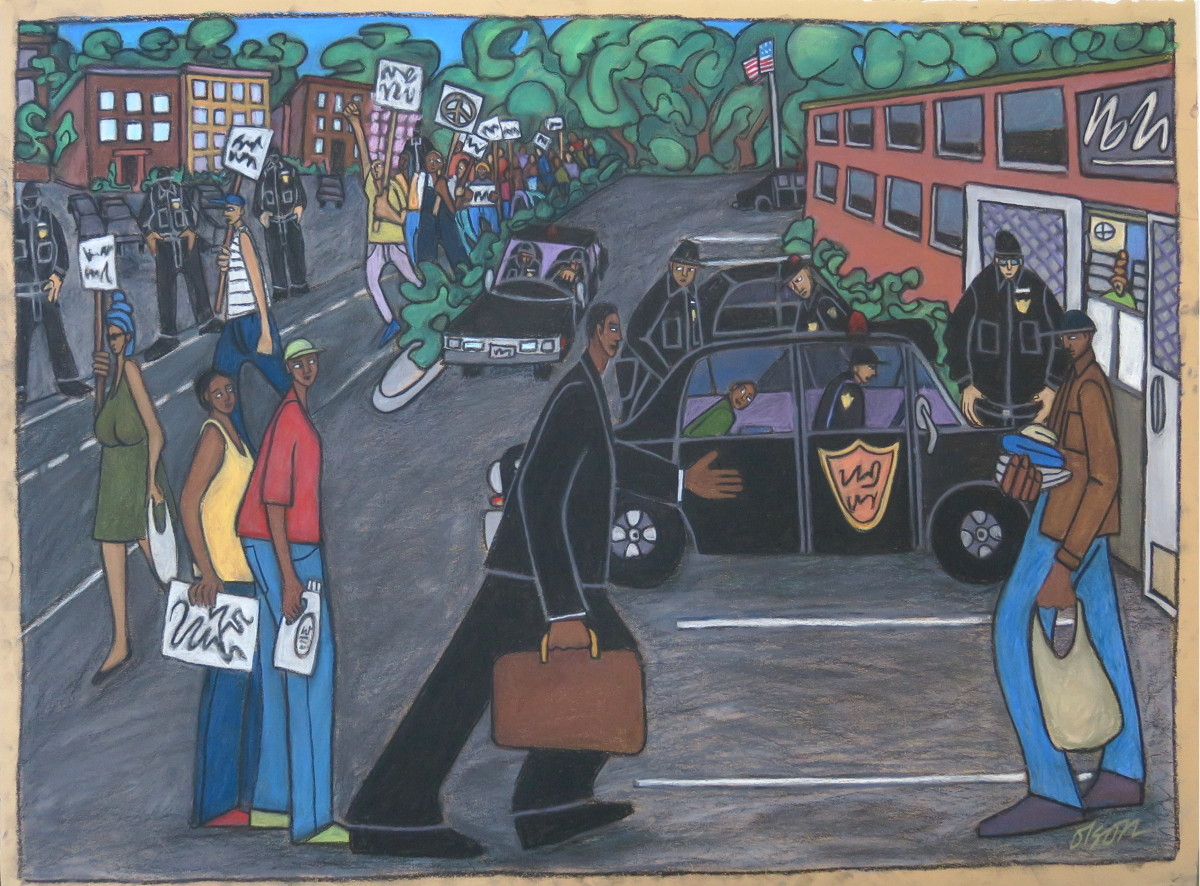
19.5″ x 29″ pastel on paper $1,150 framed
Mutual aid is the practice of ordinary people helping others in their community by providing resources and services to help meet people’s needs. Local community bail funds exist to support people when the government does not. Through wealth-based detention that results from the use of cash bail, our cities, states, and counties have shirked their responsibility to preserve the presumption of innocence, establishing a two-tiered system of justice: one for the rich, and another for everyone else.
Charitable bail organizations provide free bail assistance and even supportive services—such as court reminders and transportation assistance—to incarcerated people who have already been deemed eligible for release by a judge. In fact, many of the legally innocent people they help have been accused of low-level nonviolent misdemeanors, such as forgetting to attend a scheduled court date. Oftentimes, the only reason people remain incarcerated in jail before trial is because they cannot afford to pay the court a few hundred dollars in exchange for their release before trial—not because they pose a risk of flight or public safety concerns.
In providing people who a judge has already determined are safe to release with free bail assistance and court support, we safeguard our country’s notions of liberty, freedom, and the presumption of innocence.” ( https://www.commondreams.org/…/mutual-aid-criminal-justice )
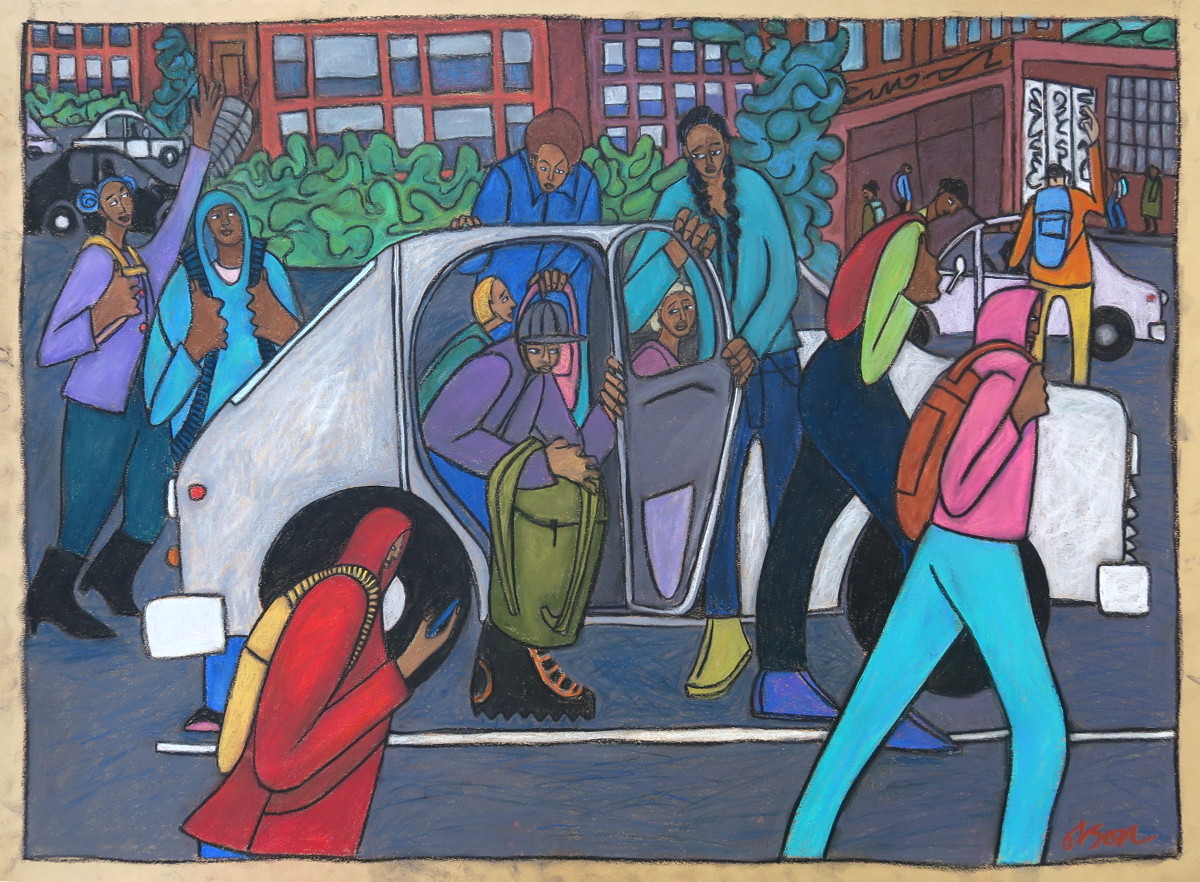
19.5″ x 29″ pastel on paper $1,150 framed
Mutual aid is an organizational model where voluntary, collaborative exchanges of resources and services for common benefit take place amongst community members to overcome social, economic, and political barriers to meeting common needs. This can include physical resources like food, clothing, or medicine, as well as services like breakfast programs or education.
Resources are shared unconditionally. These groups often go beyond material or service exchange and are set up as a form of political participation in which people take responsibility for caring for one another and changing political conditions. (Wikipedia)
Mutual aid transportation is typically known as a service that provides transportation to folks in need. Ride sharing for young people provides needed transportation to school, work and home. It is an early lesson in caring for others
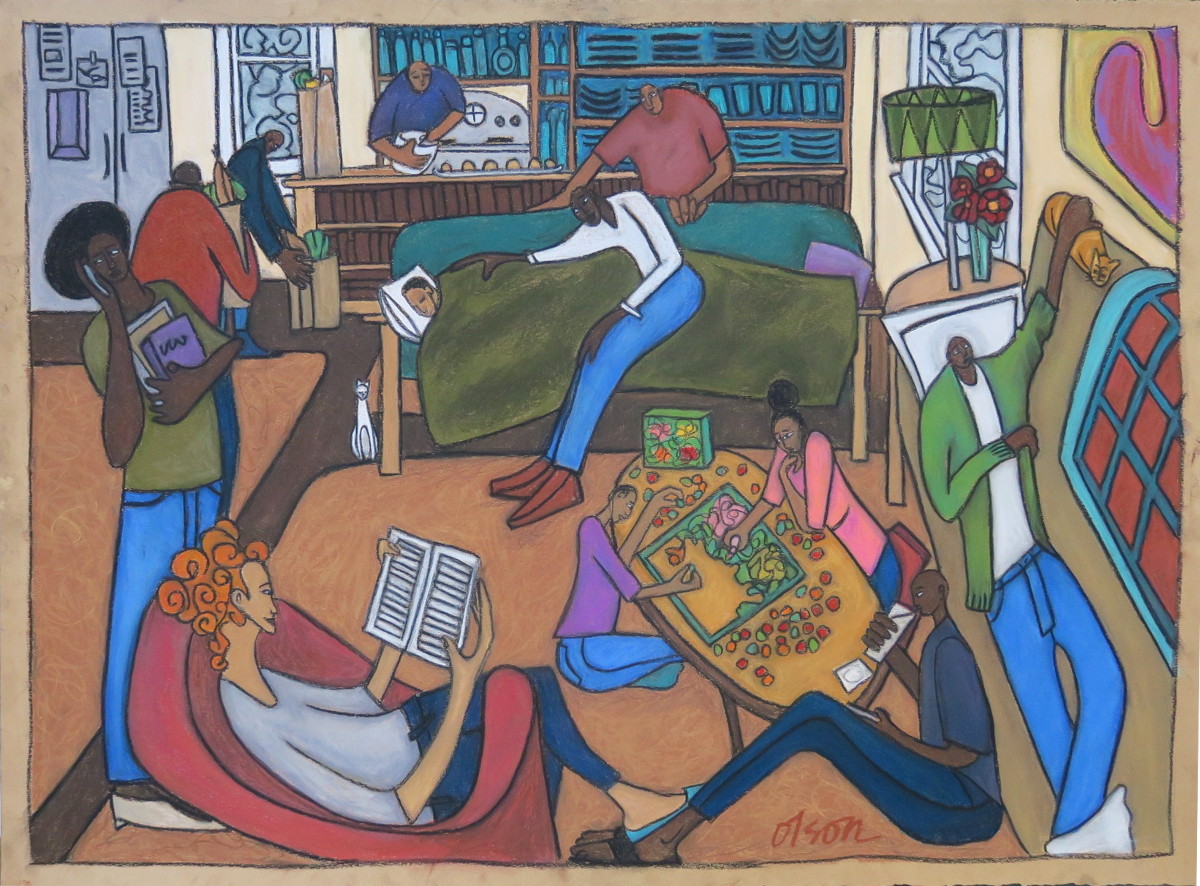
19.5″ x 29″ pastel on paper $1,150 framed
One of the first groups in the US to assist people living with HIV/AIDS in the 1983, Berkley, CA. Shanti Project was modeled on the principles of the disability rights independent-living movement. Shanti secured two homes and began the process of housing people with AIDS, with priority given to those most at risk of losing their homes or who lived on low incomes.
Practical support volunteers helped paint and set up these homes prior to the residents’ move-in date and helped with their chores if they were too sick to work. Along with maintenance specialists, Shanti hired “resident advocates” who held monthly house meetings to hold support groups and check in with the house dynamics. Many Shanti residents would spend their final days in these homes, but the residences were not hospices. By the end of the 1980s, Shanti had more than ten residences in operation. With their addresses kept secret from those not affiliated with the program, these homes became communities. Through Shanti, people with AIDS were not only housed, they had a home.
Shanti’s holistic response to the AIDS crisis was another step in the evolution of mutual aid. This approach cares about the whole person in one of their most vulnerable moments.
https://daily.jstor.org/

19.5″ x 29″ pastel on paper $1,150 framed
The Bike Cave is a volunteer-run no-cost bike shop located in the basement of the Dorothy Day House, Duluth, MN. There are many versions of Duluth’s Bike Cave throughout the world. Typically, all skill levels are welcome and folks strive to provide a safe space for people to repair or build a bicycle. There is no monetary charge for any bikes or bike parts. New bicycle enthusiasts can expect to get their hands dirty while working alongside one of our volunteer mechanics. Veteran bikers can come to access the shop tools. While bikes do not cost money folks are expected to participate in the maintenance of their bike and/or help with a volunteer project around the shop.
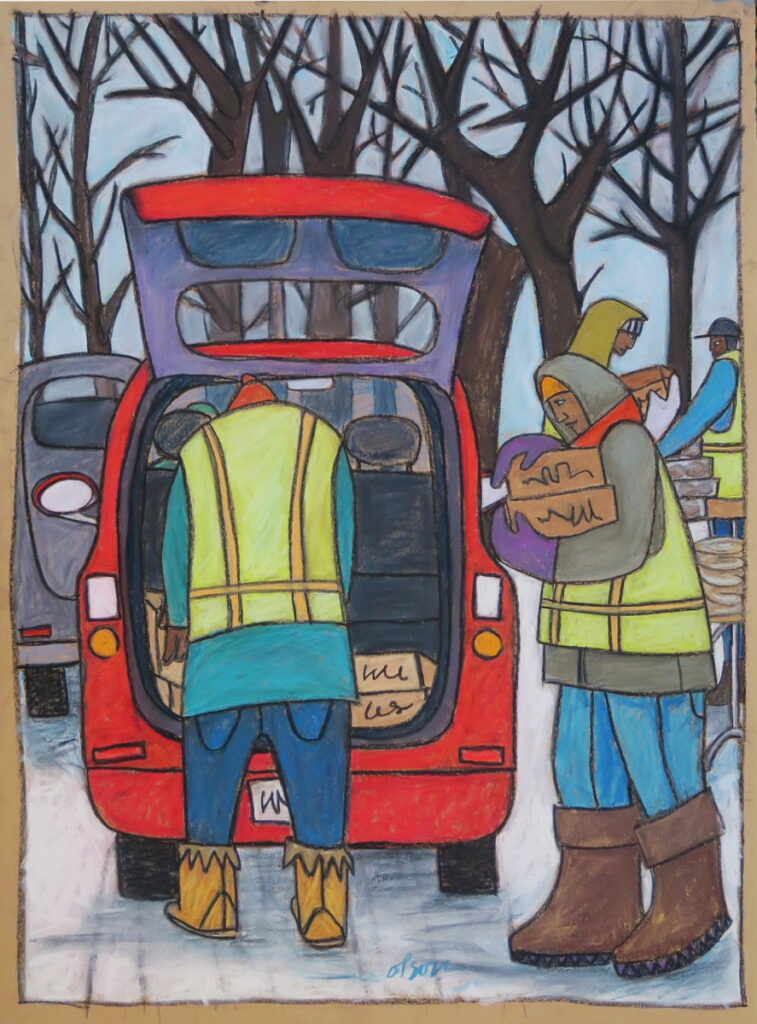
19.5″ x 29″ pastel on paper $1,150 framed
Seniors who are unable to drive or get transportation to shop for groceries depend on volunteers to deliver groceries. Food Banks and other neighborhood programs provide regular deliveries of free groceries which may including shelf stable items along with fresh groceries. Volunteers package and deliver items.
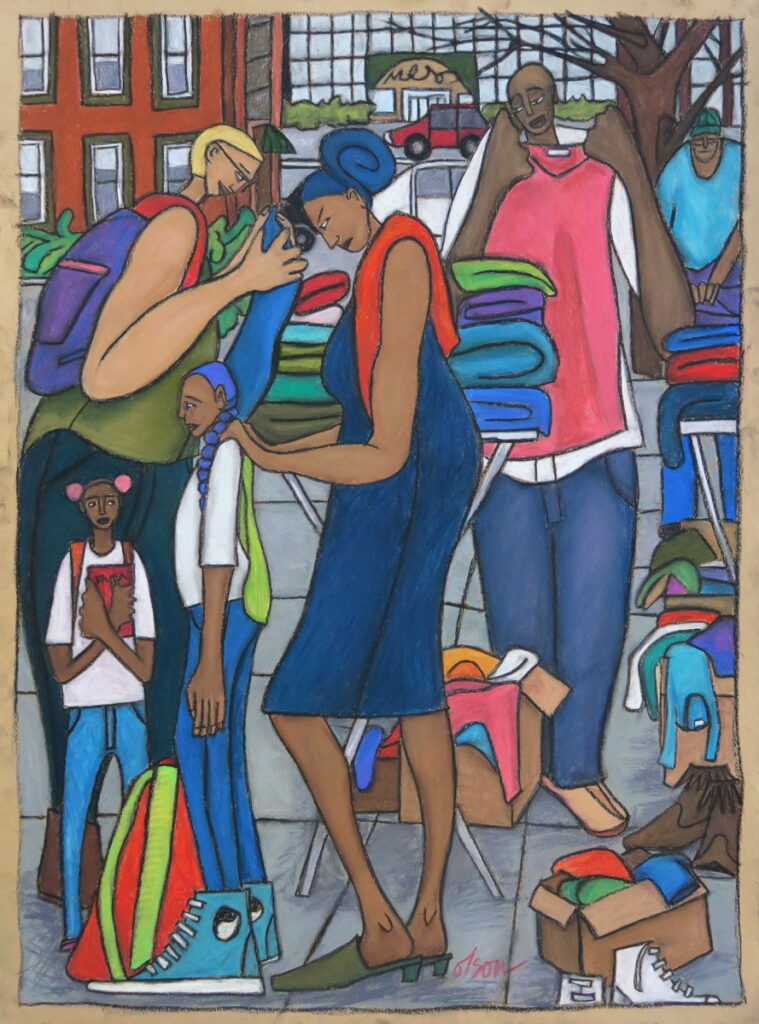
19.5″ x 29″ pastel on paper $1,150 framed
Through Mutual Aid Clothing Exchanges everyone is welcome to bring gently used clothing items that they no longer wear or want, and in exchange, they can select new items from the clothes that others have brought. Clothing exchanges assist folks by providing free clothing.

19.5″ x 29″ pastel on paper $1,150 framed
Brake Light Repair Clinics are events where organizers change people’s broken tail lights for free in order to to reduce police interactions and have discussions with people about their personal experiences with police.
More than 50,000 drivers are pulled over in a traffic stop every day in the U.S., according to the Stanford Open Policing Project. Reports document black folks being pulled are over 20 percent more likely to get a ticket than white drivers, underlining the stark racial disparities within the criminal justice system.
The process for fixing brake lights is simple, but will help in reducing community interactions with police and help educate the community on legislation that activists are interested in passing.
Brake Light Clinic impact our communities by reducing the number of police interactions working-class people encounter due to bogus reasons such as broken brake lights and building relationships with our neighbors!
(https://mutualaid.dsausa.org/)

19.5″ x 29″ pastel on paper $1,150 framed
“Laundry Love” is a national organization dedicated to providing laundry services to people with low and no incomes. Our local chapter in Duluth, MN is now in full swing offering free laundry services once a week. Volunteers staff Spin City (Spirit Valley) laundromat for three hours at a time, offering people the chance to wash up to two loads of clothes per week. Laundry Love volunteers provide snacks and activities as well, hoping that this service is more than just a place to clean your clothes, but an opportunity to build and celebrate community.
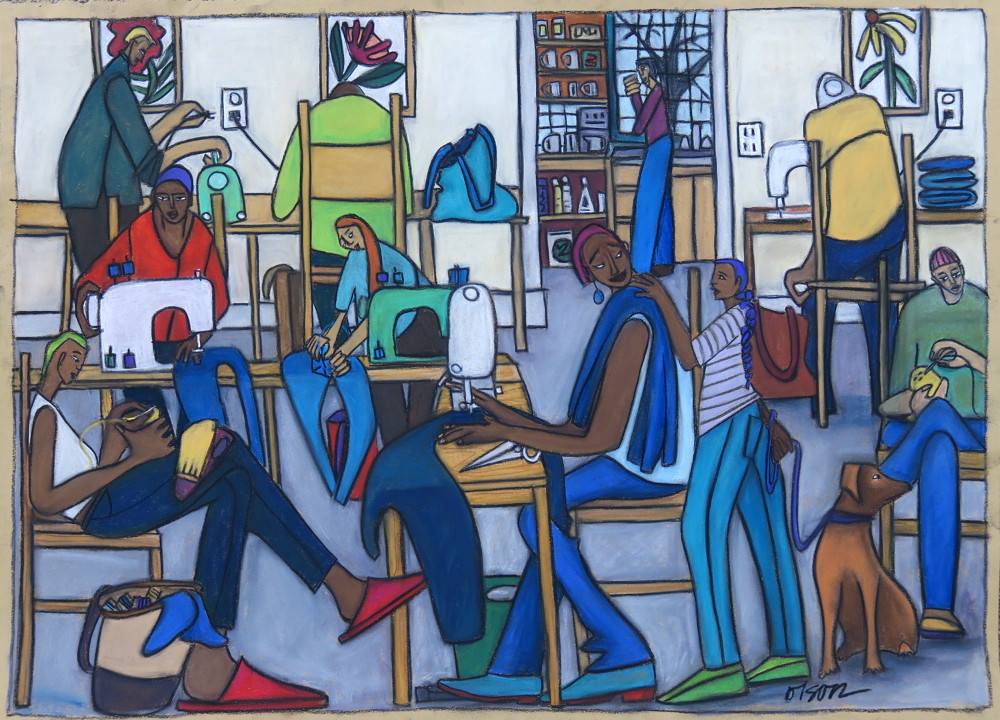
19.5″ x 29″ pastel on paper $1,150 framed
Mutual aid mending involves community-based repair of clothes and other items, often focusing on darning socks to extend their lifespan and reduce waste. This practice, rooted in mutual support, can be done individually or collaboratively, offering both practical skills and a sense of connection.
Mending Bloc a mutual aid group in Portland, Oregon who mend clothes and other things for the community, as well as distributes mending kits, patches & zines to help people mend their own stuff. They also make and distribute other fabric-based things that are helpful to others.
“We do our small part in the fight against the evils of capitalism to help people use what they already have and empower them to help themselves and others to mend, make, and remove the need to buy as much as possible!” https://mendingbloc.carrd.co/

25″ x 50″ pastel on paper $3,000 framed
Rent parties were a common mutual aid practice in New York during the Harlem Renaissance and the decades that followed. Proceeds from entrance fees and refreshments at the parties went toward helping offset some of the discriminatory rental rates that Black tenants faced. The parties were advertised with rent party cards that often had little rhymes on them. Langston Hughes found these delightful and had an extensive collection.


The legacy of rent parties continues today! The Black, trans-led collective For the Gworls raises funds for Black transgender people to pay rent, access healthcare and get gender affirming surgeries through monthly parties. Rent parties provide support to marginalized folks living in poverty through chosen family and mutual aid. However, more frequently, mutual aid fundraisers today take the form of Venmo exchanges, Facebook posts or GoFundMe pages.

19.5″ x 29″ pastel on paper $1,150 framed
Art as resistance refers to the use of artistic expression to challenge, critique, and confront social, political, or cultural norms, often with the aim of sparking change or raising awareness about injustices.
Examples include: spontaneous street art and graffiti created in protest to the killing of George Floyd, Dante Wright, Breanna Taylor and others; Black Lives Matter murals, music and performances; Anti-apartheid murals as powerful visual statements opposing the racist regime; and Anti-war paintings by Picasso and Goya as well as and street art by Banksy just to name a few.
Know that art has been used by dictators and fascist regimes against us as well to maintain control. Examples include: WWII’s Nazi Germany’s graphic propaganda with swastikas’ and “Aryan ideals” which opposed modern art (Bauhaus) and expression. Their excessive pageantry created a false narrative of community support for their cruel policies; the Soviet Union glorifying cruel leaders like Stalin while silencing dissenting artists and communities who chose to speak out against the regime; and Mao in China used powerful graphics to reinforce loyalty to the communist party/Mao
Its important to know the key ways they employ art to maintain power: Dictators establish and maintain their authority through a carefully cultivated image of being powerful, infallible leaders. This is often achieved through widely circulating portraits, statues, and symbols of the leader to reinforce their authority and deify them. Creating monumental public buildings and monuments that convey a sense of grandeur, strength, and the regime’s dominance. Art is used to rewrite history, presenting a version that aligns with the regime’s narrative and justifies its actions. Authoritarian regimes tightly control artistic expression, promoting only the art that aligns with their political agenda and suppressing any forms or artists deemed subversive. Artists who resist face severe consequences like persecution, censorship, or worse.
Remember that art can also be a powerful tool for resistance against oppressive regimes. Artists often find ways to subtly embed messages of dissent or critique within their work, even under strict censorship. This can involve using allegory, metaphor, and other forms of symbolism to convey subversive meanings. Art, in this context, becomes a vital means of resistance, resilience, and maintaining individual autonomy. (Ms. Google)
I have found drawing a way to deal with anxiety about the fascist regime currently running our country. Join me in speaking up for our family and neighbor’s. Stay safe. Stay strong.
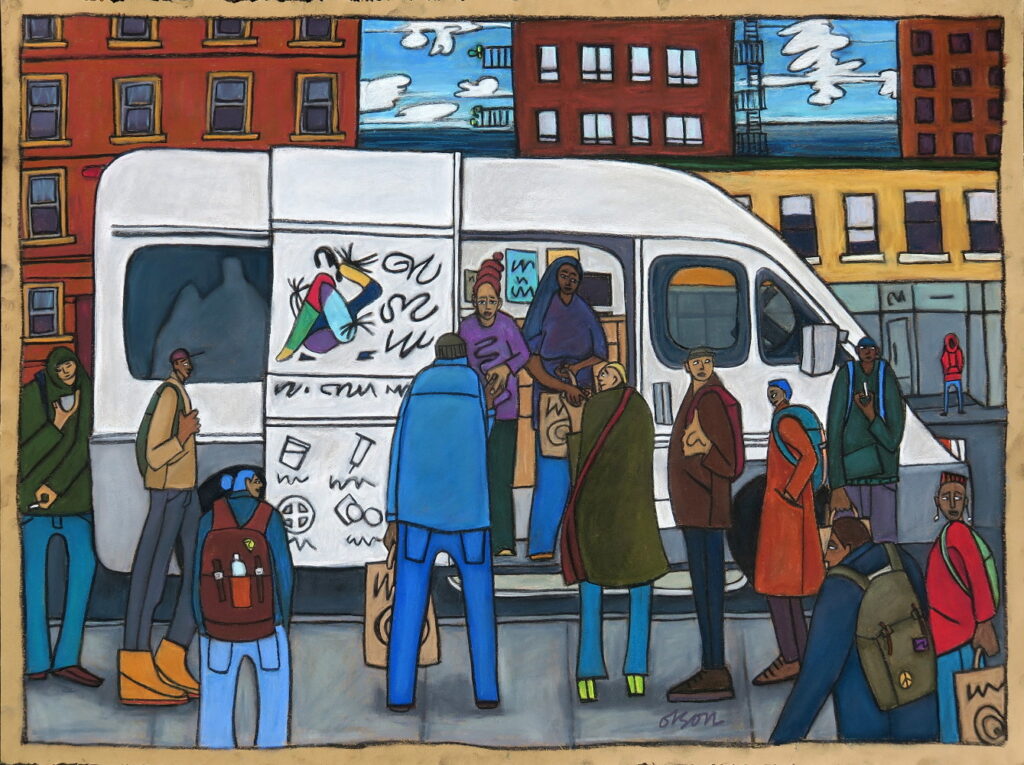
19.5″ x 29″ pastel on paper $1,150 framed
Harm Reduction Sisters provides a feminist response, using innovative harm reduction principles and practices to address the gaps that exist for people who use drugs and experience trauma. Since Fall 2021, they have provided mobile, confidential rapid HIV testing and Non-Medical HIV Case Management in Duluth and surrounding communities. They also support folks by providing safer injection and smoking supplies, Narcan, non-medical HIV case management, harm reduction education, drug checking, and more– all at no cost gives folks another day to do better for themselves. They save lives.
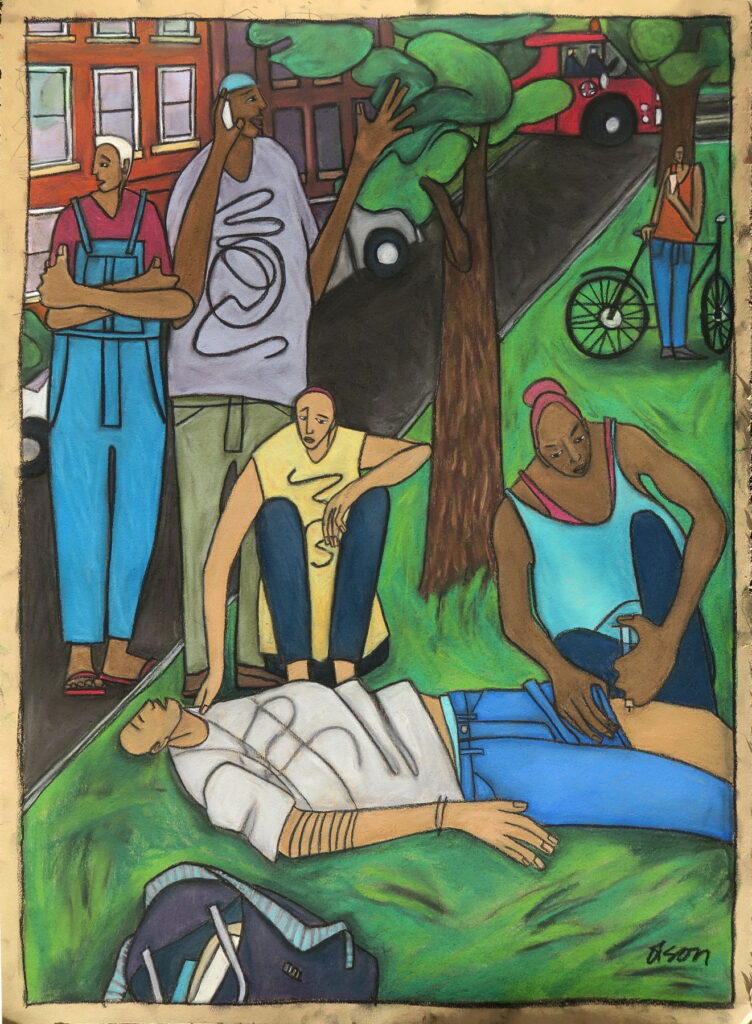
pastel on paper 19 1/2″ x 29″ $1,150 framed
Naloxone is an opioid overdose reversal medication. Opioids can slow or stop breathing. Naloxone works by blocking the effects of opiates on the brain and restoring breathing. Community members can carry Naloxone easily with them in backpacks or bags just in case they come upon someone who is overdosing. By administering Naloxone a life is saved.
Naloxone can be purchased through a pharmacy but is often available free through community programs like Harm Reduction Sisters, Duluth, MN. Community service programs may also offer training on how to use it, other harm reduction services, and access to recovery resources. Naloxone is free because it’s a public health priority to save lives from opioid overdoses, and many government, non-profit, and health organizations fund its distribution.

pastel on paper 19 1/2″ x 29″ $1,150 framed
Safe Bay is a program in Duluth that provides secure overnight parking for people living in their vehicles, along with services like showers, bathrooms, laundry and Wi-Fi. Often folks work full time but can’t afford housing. Safe Bay also offers support from outreach workers to help with housing applications and other community services. The program operates nightly from May 1 through October 31, depending on its current operating status and location. Safe Bay is open to anyone who doesn’t have a permanent place to live and is relying on their personal vehicle (car, truck, van or camper) for shelter. Families and pets are welcome.
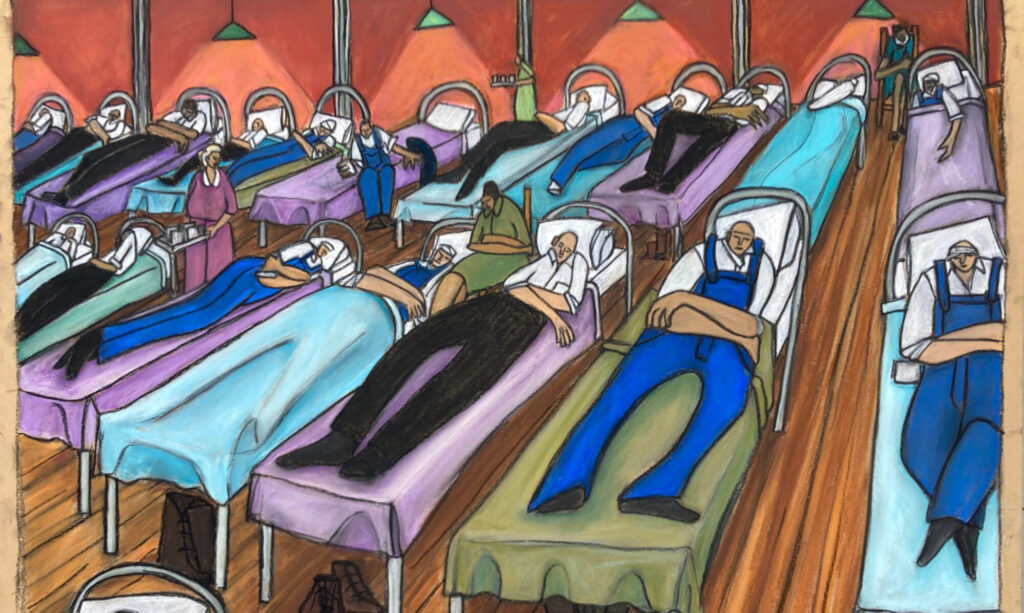
pastel on paper 19 1/2″ x 29″ $1,150 framed
During the 1934 Trucker Strike in Minneapolis, MN the Women’s Auxiliary Infirmary provided safe space for exhausted and injured strikers to rest and recover from the violence. The Women’s Alliance Protest at Minneapolis City Hall Against Violence depicts women adding their voices in nonviolent protest against the Citizens Alliance and business owners instigating the violence.

pastel on paper 19 1/2″ x 29″ $1,150 framed
Women’s work during the 1934 Truckers Strike in Minneapolis,MN. Inspired by the writing “I Was Marching” by Meridel Le Sueur.
The Women’s Auxiliary Food Kitchen was open to the striker’s families. Le Sueur’s description of the kitchen showed the work was demanding and endless. She joined in with other women and family of the strikers in preparing and serving food, washing dishes and pouring coffee.

Arrowhead Regional Arts Council receives generous funding from the taxpayer’s of Minnesota’s legislative appropriation from the arts and cultural heritage fund.

Individual Artists Equity Grant is made possible in part by the voters of Minnesota through a grant from the Arrowhead Regional Arts Council, thanks to a legislative appropriation from the arts and cultural heritage fund. fund
